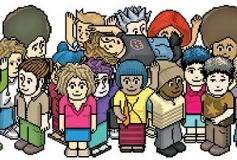
The KULTA project, a collaboration between
The seminar is intended for researchers working in disciplines related to to socio-cognitive modeling including but not limited to sociology, economics, cognitive science, and computer science.
REGISTRATION
Please, inform us about your participation on Friday, 29th of May
at latest to Tommi Vatanen (first.last at tkk.fi).

PRELIMINARY TIMETABLE
09:15-09:45
Abstraction levels in socio-cognitive modeling
For instance, what aspects of human activity need to be included in the model? For consumption related models, we might probably skip functions related to human biology (e.g. food digestion process, breathing, blood vessel), but food on the abstraction level of "breakfast", "lunch", "dinner" and eating at restaurants, malls, or cafés might be relevant.
Also, some algorithms in socio-cognitive modeling aim to group similar people and/or similar things and display them close to each other. The problem is that while an object might be similar to another based on physical properties, these objects might appear as very different from the perspective of economics, inherent technology, or everyday life. This is why the chosen abstraction levels and related variables in any socio-cognitive modeling application is key to its success.
The introductory presentation focuses on what kind of abstraction levels may be considered, and what is the relationship between these levels. Moreover, the concept of emergence is discussed.
Background:
Advanced material:

09:45-10:45
Modeling Virtual World Consumers: Case Habbo
Lehdonvirta (2009) has published a model on "virtual item attributes" that act as purchase drivers. The model includes functional, hedonic, and social attributes: performance, functionality, visual appearance and sounds, background fiction, provenance, customisability, cultural references, branding, and rarity. These attributes (and their abstraction levels) can be used to understand consumer behavior and create socio-cognitive models of consumers.
 Some Habbo facts (April 2009):
Some Habbo facts (April 2009):
Background:

10:45-11:00 Coffee break
11:00-11:30
Analogies between concepts and practices:
Processes of emergence, learning, diffusion, and disintegration
Language use is an example of activity for which both individual and social level are relevant. We consider here language use as a practice. Words, phrases and the corresponding concepts come into existence, persist and disappear. The material level includes the media for written and spoken language, the image refers to actual language use, and the skill is related to the ability to use suitable expressions in appropriate contexts as a cognitive activity. Here concepts are considered as mental "objects" even though it appears to be more proper to consider them as dynamic entities.

11:30-12:00
Challenges and research questions in socio-cognitive modeling
Principles of diffusion and communication in agent communities
An agent is autonomous decision maker that bases its decisions on the environment. That means, it can communicate with other agents and change its behavior according to the changes in the environment. Multiagent simulation is a computational system that consists of several autonomous agents that interact during the simulation. One way to improve a multiagent model is to utilize the diffusion of innovations theory. This theory classifies agents to early adopters, secondary adopters, tertiary adopters, etc., based on how fast they adopt new innovations. This introductory presentation describes the basic concepts related to diffusion and communication in agent communities.
Narrative versus conceptual structuring of reality
Jerome Bruner, an American psychologist, has suggested that there are two primary modes of thought: the narrative mode and the paradigmatic mode. Narrative thinking can be defined as sequential, action-oriented, and detail-driven thought. On the other hand, paradigmatic thinking has systematic, and categorical cognition in focus. The latter emphasizes the conceptual organization of reality which seems to dominate the scientific thinking and representation. In this introductory presentation, the ideas behind narrative thinking are discussed.
Relationship between models, scenarios and reality
Is all this useful? What kind of methods could help in handling scenarios of future consuming and its effects?

12:00-13:30
Lunch and group work: "Thought experiments"
It has been suggested that thought experiments are more similar to computer simulations than they are to arguments (James McAllister, Models and Simulations 2, 2007). A famous example of a thought experiment is the Chinese Room argument by John Searle, which attempts to show that a rule-based symbol-processing machine can never be properly described as having a "mind" or "understanding", regardless of how intelligently it may behave.
There are many different kinds of thought experiments. All thought experiments, however, employ a methodology that is a priori, rather than empirical, in that they do not proceed by observation or physical experiment. Thought experimentation is the process of employing imaginary situations to help us understand the way things really, or understand about something in the future (cf. scenarios).
During the lunch session, we develop thought experiments related to socio-cognitive modeling.
Background:

13:30-15:00
Hands-on experiments

15:00-15:30
Abstraction levels in socio-cognitive modeling
Summary, conclusion and discussion: